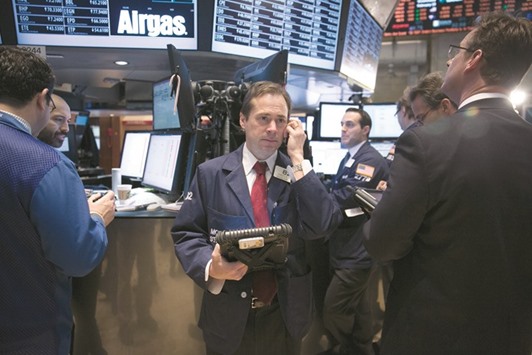The US options market is underpricing the risk of British secession from the European Union, according to a New York-based firm that arranges volatility trades.
Implied volatility for S&P 500 Indexat-the-money contracts expiring in 30 days sits at 15.1%, a price that is actually below the average level of the past year, according to data compiled by Bloomberg. Placidity can also be seen in the benchmark index’s fear gauge, the options-derived benchmark which has fallen 12% in the last week after reaching a four-month high.
With the potentially market-moving referendum set for today, strategists at Macro Risk Advisors say investors should be bracing for bigger price swings. A vote to leave the EU would unleash turmoil across global markets, the type of outcome for which investors have historically been unprepared, according to MRA.
“If you’re looking to hedge with the pound, people already beat you to it,” Dean Curnutt, chief executive officer at Macro Risk Advisors, said in a phone interview. “But when you start to get away from the UK and Europe, there’s an opportunity to buy options and insurance on things like the S&P that didn’t reflect the potential for spillover. In the past, the market hasn’t shown a very strong ability to understand risk and price outcomes based on politics.”
One cost-effective way for an investor to protect against a market decline would be to use three-month put spreads, strategies designed to hedge against a short-term drop in an asset, according to MRA. Such protection now costs roughly the same as it did a year ago, a comparatively quiet period for markets, the firm said.
Viewed as the more likely outcome as recently as last week, the Brexit option has seen its popularity wane. A poll published over the weekend showed 45% of voters supported remaining in the union, while 42% favoured leaving. Odds at betting shops also suggested dwindling support for the secession following the murder of UK lawmaker Jo Cox, who backed staying in the EU.
Still, anything with a probability of 30% or more “ceases to be a tail risk and must be confronted as a realistic potential outcome,” MRA wrote in a June 9 client note.
As the likelihood of a Brexit has decreased, so has the CBOE Volatility Index, which slipped 5.4% on Monday, the most in four weeks. The gauge of price swings has fallen in four of the last five sessions and, at 18.37, sits below its 10-year average. The volatility index generally trades inversely to the S&P 500.
Resilience has been a guiding principle this year in the US stock market, where investors have been unwilling to embrace bearishness. With a 0.6% gain on Monday, the S&P 500 sits just 2.2% from an all-time record even after two straight weeks of declines. The benchmark gauge bounced back earlier this year after getting off to its worst-ever start, erasing an 11% loss in less than two months.
While the recent spot price may indicate less worry heading into the Brexit referendum, that hasn’t stopped investors from piling into VIX-linked products. Trading in five of the most popular VIX instruments surged to more than 4% of total volume on US exchanges, a level that before last week had never been reached, according to data compiled by Sundial Capital Research and Bloomberg.
Meanwhile, as of June 7, hedge funds and large speculators held more short bets on VIX futures than at any time since 2013, according to data from the US Commodity Futures Trading Commission. Less than a quarter of these short positions were covered during last week’s 14% VIX increase, making calls on the gauge an “excellent hedge” for a long portfolio, according to Schaeffer’s Investment Research.
“Short-term VIX calls remain an attractive portfolio hedge in the event that market participants react unfavorably,” Todd Salamone, senior vice president at Cincinnati-based Schaeffer’s Investment Research, wrote in a client note on Monday. “We see short volatility speculators as particularly vulnerable to a negative surprise.”

Traders work on the floor of the New York Stock Exchange (file). Resilience has been a guiding principle this year in the US stock market, where investors have been unwilling to embrace bearishness.
